The Trail of the Cork cutters
"Ruta VI La Umbría" (GR-141)
"Ruta VI La Umbría" (GR-141)
I named this walk the trail of the cork cutters, because the first half of the trail you walk through a cork oak forest and if your timing is right, you will be able to witness how the bark (cork) of an oak tree is peeled off, and then still today as for centuries, transported on mules back to a collection point. This procedure happens every 9 - 12 years when a tree has been shed of its bark.
From the village of Gaucín there are 12 hiking routes raging from 3 - 12 km which are signposted in Roman numerals on white ceramic plaques with blue writing. On a fine day in May we decided to take the the route "Ruta VI La Umbría" (GR-141). It is a 6,25 km circular trail and fairly easy to walk. The first part takes you through a mature cork oak forest and about halfway you will see chestnut trees which have been cultivated. You will see many other trees, like various pine trees, Holm oaks as well as different shrubs and large ferns on the way.
Springtime or autumn is the best time to visit this area around Gaucín. I am always amazed at the great variety of wildflowers as well as many types of wild orchids you are able to see in the countryside of southern Spain. We also see many different types of butterfly and other insects. Because of the proximity of the nature reserve Los Alcornocales and Campo de Gibraltar you might spot different migratory birds, mainly in spring or autumn. We saw black storks flying over head as well as Griffon Vultures, which are always present around Sierra del Hacho.
So soon you turn away from the coast the countryside and the panoramic views along the way are amazing.
The village of Gaucín lays 600 m above see level and on its highest point are the ruins of Eagles castle (Castillo de Aguila). The topographical layout of Gaucín and its surrounding area, and not only the views are stunning but also the natural surroundings amazing.
Towards the west you view Los Alcornocales Nature reserve, to the north the Serrania de Ronda, to the east Sierra Bermeja and Sierra Crestellina and to the south the Campo de Gibraltar, and on clear days, the north African coast and the Rock of Gibraltar.
This panorama followed us throughout the drive there and the hike.
Directions:
- From Marbella on the Autopista A-7 you drive westwards.
- Take exit on toll road by Manilva direction Casares A-377.
- When you turn of the Toll road you will see a big quarry to the right, the road to Casares/Gaucín leads above it and alongside a windmill park.
- To reach the village Gaucín, it is about 67 km and it takes roughly 1 hour, including stops at viewpoints.
- It is a very scenic drive and you feel in harmony with nature, grazing Andalusian cows, wandering goats and horses in a field can be seen along the way, as well as birds of prey like the Griffon vulture which glide through the air above you.
- In Gaucín you take the first left and at the roundabout the first exit Ronda A-369.
- After 1 km you reach the viewpoint Mirador de Gaucín.
Map of the Hike
 |
| Wikiloc: Gaucín, Ruta de La Umbria VI |
The Hike is approx. 6,25 km circular walk. It is a fairly easy walk, partly on a footpath and on a gravel road. The last part we walked back on the side of the main road.

We follow a footpath through a oak tree forest.
As you can see on the photo the cork oak trees are fenced in.
To us it seems they are privately owned by different farmers.
The trail turns to the right and slightly uphill.
As we walked on we noticed
This section of the walk is part of the Great Serranía de Ronda trail
GR 141 Gran Senda de Serranía de Ronda.
These walkways connect most of the villages around Ronda.
Cork Oak tree, Alcornoque (Quercus suber)
The cork oak, (Alcornoque) is native to the western Mediterranean region, (Spain, Italy, France, Morocco,Tunisia, Algeria, and including Portugal). The use of the cork has a long history, dating back to the Egyptians, the Greek and the Romans for sealing jars, roofing and making beehives and many other things. In 17th century a French Benedictine monk (Don Pierre Pérignon) was considered responsible for the use of cork as stoppers for bottles to preserve wine, this method is still widely in use today.
The art of harvesting the cork from oak trees is done by skilled local people. The bark is stripped of the stem every 9 - 12 year intervals, when it has reached a thickness of 3 cm, in spring or early summer.
below the view towards the Mediterranean sea, in centre the white village of Gaucín with the castle "Castillo del Aguila" to the left.
We come across a large Eucaliptus tree.
The tree is entwined with Evy, there must be quite a lot of precipitation in this area.
Even the sight of a partly dead tree can be an imposing feature on the landscape.
At times the footpath is quite narrow and you have to be sure of your footing.
 |
| Very interesting link about pine trees, Málaga Provincial Council |
Some of the wildflowers next to the footpath
A beautiful butterfly which has settled on a leaf for a brief moment.
 |
| Click on Link: Málaga Provincial Council, Nature, Butterflies |
 |
| Jerusalem Sage, Matagallo, (Phlomis purpurea) |
The footpath is now much wider.
We walked through a gate.
The sign reads, that you are asked to close the gate again after you.
A lovely old Holm oak (Encina)!
In the distance we view the Sierra del Líbar.
Below the limestone mountains we barely can make out the white village of Cortez de la Frontera.
A view back to where we come from.
A jungle of large ferns!
A beautiful huge Holm oak, we wonder how old it must be!
What a beautiful photograph!
This old cork oak tree grew very knobbly.
Still, his bark (cork) is going to be shed.
 |
| Interesting link: Cork oak, Alcornoque, Málaga Provincial Council |
An unusual bell flower standing over 1 meter tall.
Looking back at the old oak tree we passed earlier.
About half way along, we come across a white building.
After a closer inspection it most probably is used by the farm workers to store cut off cork or chestnuts etc......
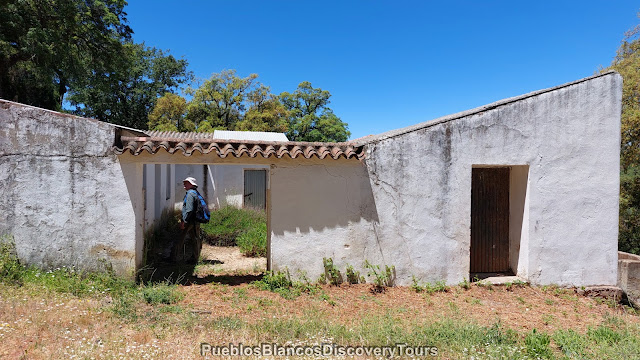
We thought this field makes an ideal location for a picknick.
We look so dwarfed next to these large oak trees.
It is very visible where the bark has been shed.
The new reddish brown bark is growing fast
Now we come to the area of the chestnut trees.
 |
| Interesting link about chestnut trees, Málaga Provincial Council |
At this time of year late spring you see chestnut trees flowering.
A view across a still young chestnut orchard.
This view is towards the south/west along western side of Sierra El Hacho
and across towards Alcornocales Nature Reserve.
This view must be especially beautiful in autumn when the leaves of chestnut trees change their colour.
We come to a crossroad and by the fountain we turn right uphill.
From here it is only 200 meters to the main road A-369 Gaucín to Ronda.
 |
| Pink rock roses |
Red and white stripes painted on rock serves as a way sign.
At the end of the chestnut forest we come to a gate and you can see the main road from here.
At the road the sign marks the entry to the municipality of Gaucín.
We turned right walking south along the main road.
On the way we come across another viewpoint with some more cork oak trees.
In the centre you see the reddish brown mountains of
Sierra Bermejas and Los Reales.

Below, the Sierra de Crestellina and the view towards the Mediterranean Sea.
Normally along this short stretch, there is not much traffic on this road and you are very much compensated with the panoramic views you get along the way.
Yellow bushes lining the roadside.
The Yellow Broom bushes which line the main road are in full bloom
from April until July.
 |
| Yellow broom , Retama, (Retama sphaerocarpa) |
To see a ladybird is a rare sight for me.
The ant and the ladybird are on the same mission, I wonder!
 |
| Interesting link about the Yellow Broom, Málaga Provincial Council |
As we are walking we can fully enjoy the panorama.
Ahead, we view the castle of Gaucín.
We certainly have enjoyed this walk and the beautiful natural surroundings.
Next time we will do it in the autumn.
Map of the Hike
How to get to Gaucín
Related Blog: Gaucín, the Walk to the top of "el Hacho"
Related Link: Great-Serrania-de-Ronda-Path-GR-141-stage-03-








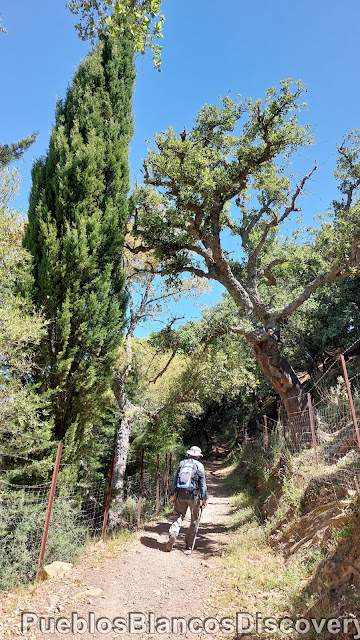
















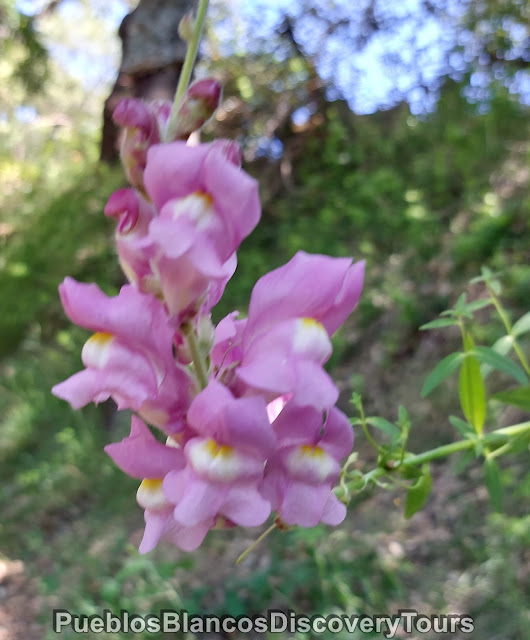


















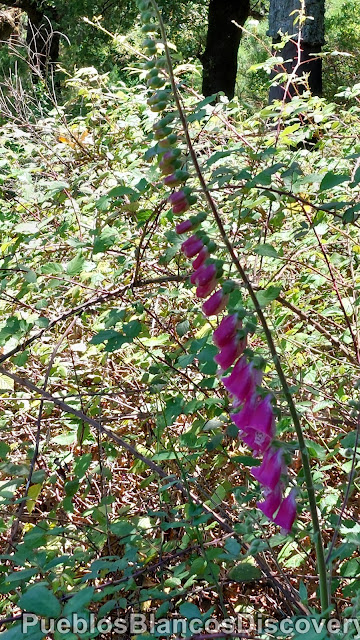






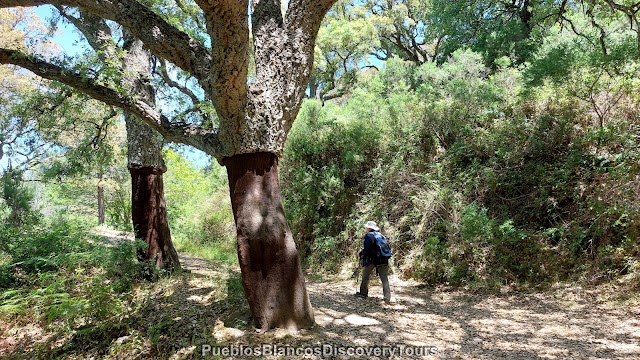



























No comments:
Post a Comment